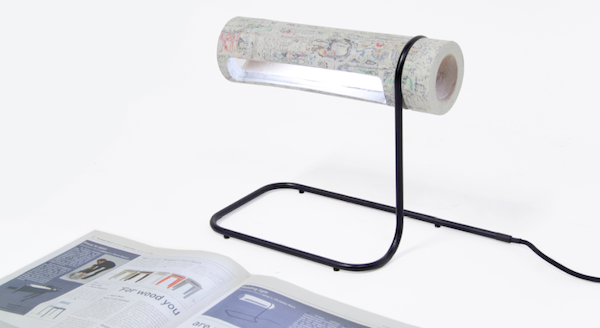

Day-old newspapers can line a birdcage or wrap a trout just fine, but a group of Dutch designers is finding a more lasting way to recycle yesterday’s headlines.
“We upcycle,” NewspaperWood co-developer Arjan van Raadshooven told me. “We use something that loses value the next day to temporarily make something else.”
Van Raadshooven and fellow designer/developer Anieke Branderhorst explain that they turn old papers — often unsold misprints still in 50-paper stacks — into logs of wood, which are then used to make desks, jewelry, cabinets, chairs, lamps and anything else they might think up. Prices range from €85 ($107) for a small pendant to €4,520 ($5,694) for a desk. A reading lamp will run you €389 ($490), and a display cabinet is €2,570 ($3,237).
The concept originated with Mieke Meijer, who one day took a roller to some newspapers and glued them together. She added more glue and more papers, spending hours a day on the process, until she ended up with a log. Van Raadshooven and Branderhorst licensed and developed NewspaperWood through their design firm, Vij5. Logs are now produced by machine.
“We do not make square blocks, we make round tree logs,” Van Raadshooven said. “And if we cut it or sandpaper it, you start to see the layers. It’s interesting that sometimes you see letters or a text or words. It’s not that you can completely read it but it shows that there’s a history in the material.”
Van Raadshooven said it takes a few hours to produce each log, and that they are hard as regular wood, only with “some vulnerable points” due to the layering in production.
“If you do not lacquer it, and you sandpaper it, you really feel the paper fiber in the surface,” Van Raadshooven said. “It has a suede feel, which is really nice. It’s a live material just as wood is. If you ever have piece of oak wood it becomes yellow over time. If you have a newspaper and you leave it in the window for a few days, it also becomes a little bit yellow. We do not try to prevent that, we try to use it.”
Designers also make a point of preserving the newspaper aesthetic within the finished products. Necklaces strung with NewspaperWood pendants are framed with brass engraved with the date of publication. As cabinets and desks made of NewspaperWood age, they also warp, sometimes revealing bits of text or ink color previously unseen.
“You can see the origin of the material in some surprising parts,” Branderhorst said. “Sometimes just a little piece pops up, and a really beautiful part becomes visible. Even small mistakes can project a really nice part of the newspaper. It’s not really predicitable.”
Perhaps that’s fitting: Unpredictability also captures the spirit of the industry at this particular moment in its history.
“We are sort of documenting the newspapers that are here now, something that is probably going to disappear,” Branderhorst said. “It’s a nice thing that we sort of laid still this piece in time. It freezes it for a moment.”